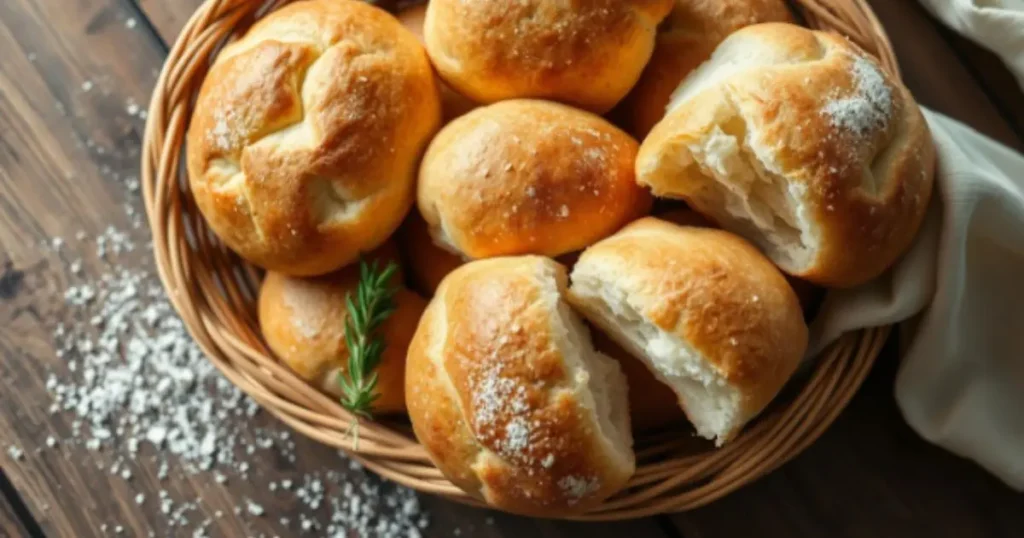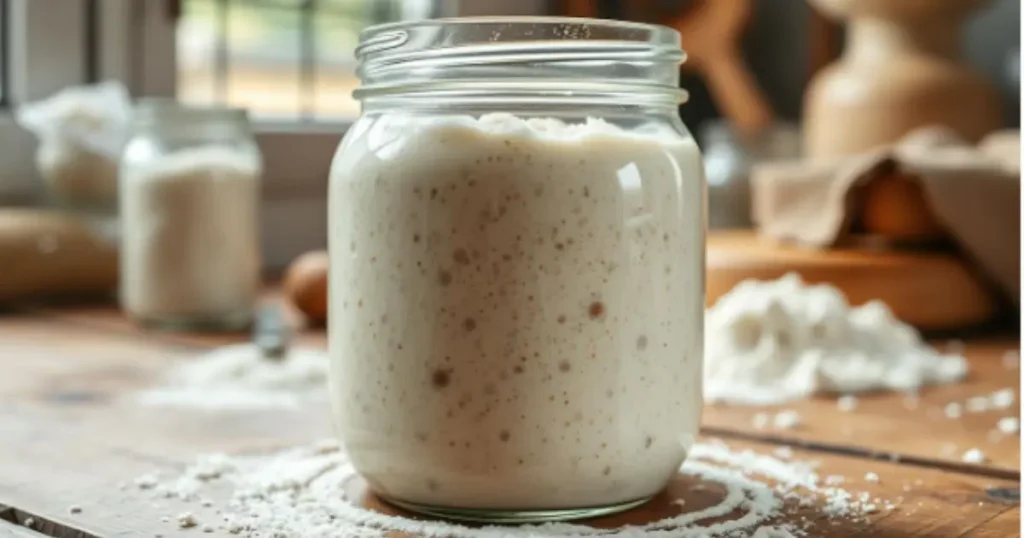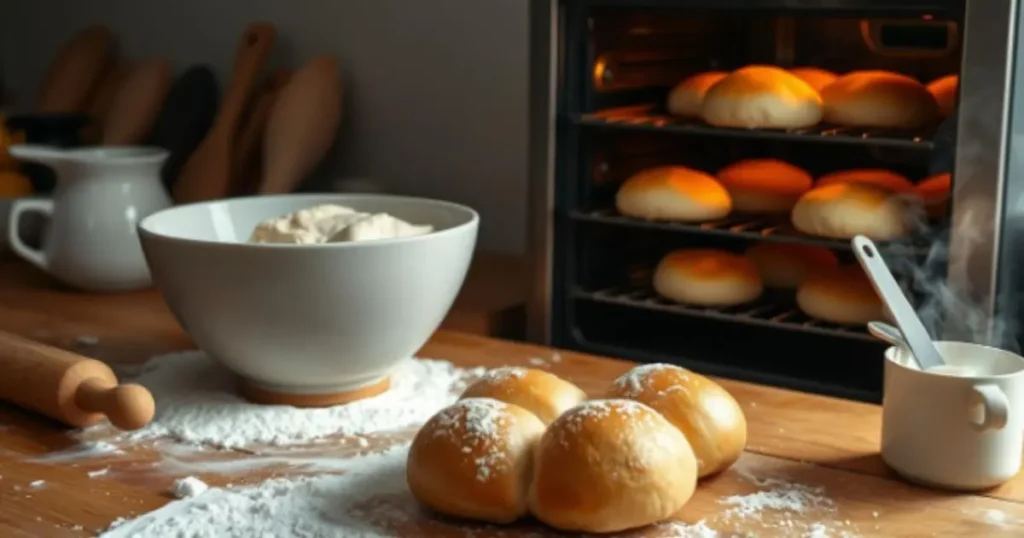The smell of fresh bread in the kitchen brings back memories and comfort. This homemade sourdough dinner rolls recipe is more than just food. It’s a journey that connects us to the history of making artisanal bread. It’s a chance for anyone to make these fluffy, tasty rolls from scratch.

In today’s world, making bread from scratch is a rare treat. Kneading, watching it rise, and shaping each roll is a calming process. It feeds both your body and soul. Making homemade sourdough dinner rolls brings many rewards, from amazing taste to the joy of creating something special.
Key Takeaways
- Homemade sourdough dinner rolls offer superior flavor and texture compared to store-bought options.
- The process of making sourdough bread at home is a rewarding and therapeutic experience.
- Sourdough is a healthier bread option, offering more nutrients and easier digestibility.
- Homemade rolls can save you money compared to buying them from a bakery or grocery store.
- This recipe provides a step-by-step guide to creating fluffy, golden-brown sourdough dinner rolls at home.
Table of Contents
Why Make Sourdough Dinner Rolls at Home
Making sourdough dinner rolls at home has many benefits. It’s not just about enjoying fresh bread. You get healthier bread, save money, and enjoy a better taste.
Health Benefits of Fermented Bread
Sourdough bread is made by fermentation. This process breaks down gluten and makes nutrients more available. It’s easier to digest and may help control blood sugar.
It also has probiotics, which are good for your gut health.
Cost Savings of Homemade Rolls
Making your own sourdough dinner rolls saves money. You only need a few ingredients and some time. This way, you get fresh rolls for less than store-bought ones.
Superior Taste and Texture
The way sourdough rolls are made gives them a special taste and texture. They have a tangy flavor, soft inside, and a crispy outside. Homemade sourdough rolls are a treat for your taste buds.
“Baking sourdough rolls at home allows you to control the ingredients and create a truly unique and delicious bread that you can’t find in stores.”
Essential Ingredients for Perfect Sourdough Rolls
Making delicious sourdough dinner rolls starts with picking the right ingredients. You need bread flour as the base and lively yeast starters for flavor. Each part is crucial for the perfect texture and taste.
First, use high-quality bread flour with more protein than all-purpose flour. This extra gluten makes your rolls light and airy. Also, a sourdough starter is key. It adds wild yeast and bacteria for sourdough’s tangy taste and special baking techniques.
Don’t forget water, salt, and a bit of sweetener like honey or maple syrup. These ingredients balance the flavors. By mixing them carefully, you’ll make soft, fluffy sourdough dinner rolls. Your family and guests will love them so much, they’ll ask for more.
| Ingredient | Purpose |
| Bread Flour | Provides structure and chewiness |
| Sourdough Starter | Contributes unique flavor and leavening |
| Water | Hydrates the dough and activates the gluten |
| Salt | Enhances flavor and controls yeast growth |
| Sweetener (optional) | Balances the tangy sourdough taste |
Avec ces ingrédients, vous êtes prêt à préparer de délicieux petits pains au levain . Ils impressionneront tout le monde par leur excellent goût et leur texture.
“The secret to perfect sourdough rolls lies in the quality of your ingredients. Start with the best bread flour and a vibrant yeast starter, and the rest will fall into place.”
Tools and Equipment You’ll Need
Starting your sourdough dinner roll baking journey needs some key tools and equipment. These ensure a smooth and successful baking experience. Whether you’re an experienced baker or new to it, the right tools are crucial. They help achieve the perfect texture and rise for your homemade bread.
Must-Have Baking Tools
- Mixing bowls: You’ll need sturdy, heat-resistant mixing bowls for the dough at different baking stages.
- Baking sheets: Quality baking sheets or sheet pans are essential for shaping and baking your dough evenly.
- Dough scrapers: These tools make it easy to release dough from surfaces and portion it out.
- Silicone baking mats: They prevent sticking and make cleanup easier by using them on your baking sheets.
Optional but Helpful Equipment
While not necessary, some equipment can enhance your sourdough dinner roll baking experience:
- Stand mixer: A stand mixer with a dough hook attachment can save time and effort in kneading the dough.
- Bench scraper: Useful for cutting, dividing, and shaping the dough.
- Baking stones or Dutch oven: These can help achieve a professional crust on your rolls.
Measuring and Timing Tools
Accurate measurements and timing are key for successful sourdough baking. Here are the tools you need for perfect rolls every time:
| Tool | Purpose |
| Digital scale | Accurately measure ingredients by weight for consistent results. |
| Oven thermometer | Check your oven’s temperature to bake at the right temperature. |
| Timer | Track proofing and baking times to avoid under- or over-proofed dough. |
With the right tools and equipment, you’re ready to make delicious, homemade sourdough dinner rolls. They will show off your baking techniques and impress everyone.
Preparing Your Sourdough Starter
Making the perfect sourdough dinner rolls starts with a healthy yeast starter. This dough is key for the tangy flavor and fluffy texture of sourdough. To prepare your starter for baking, follow these steps:
- Get a healthy sourdough starter. If you don’t have one, you can make your own by mixing flour and water and letting it ferment for days.
- Keep a regular feeding schedule. Feed your starter with equal parts flour and water, once or twice a day, to keep it lively.
- Watch for signs of an active starter. It should double in size, have a domed top, and lots of bubbles.
- Fix any starter problems. If it’s slow or smells bad, adjust the feeding or try different flour to fix it.
With practice and patience, you’ll have a strong yeast starter. It will make your sourdough dinner rolls truly special. The secret is keeping a steady feeding routine. This ensures your yeast starters are ready to go when you bake fermented dough for sourdough bread.

A healthy sourdough starter is essential for amazing sourdough bread. By properly caring for your starter, you’re on your way to baking delicious homemade sourdough dinner rolls.
Step-by-Step Sourdough Dinner Rolls Recipe
Baking sourdough dinner rolls at home is a rewarding experience. It lets you enjoy the flavors of fermented bread. This guide will help you make fluffy and golden-brown rolls every time, whether you’re new or experienced.
Mixing the Dough
Start by mixing your active sourdough starter, warm water, and a bit of honey in a big bowl. Add all-purpose flour, salt, and unsalted butter slowly. Knead the dough until it’s smooth and elastic. This step is key for your artisan bread journey.
Fermentation Process
- Put the dough in a lightly oiled bowl, cover it, and let it ferment at room temperature for 8-12 hours. It should double in size.
- Punch down the dough to get rid of air bubbles. Then, divide it into equal parts for shaping.
Shaping Techniques
- Roll each dough portion into a ball, using your palms to make it smooth and tight.
- Put the shaped rolls in a greased baking dish or on a parchment-lined baking sheet. Make sure they have enough space to rise.
- Cover the rolls and let them proof for 1-2 hours. They should grow by about 50%.
Follow these simple steps to make perfect sourdough dinner rolls at home. The fermentation process is key for the right texture and flavor. So, be patient and enjoy the journey!
Tips for Perfect Dough Consistency
Getting the right dough consistency is key for making tasty sourdough dinner rolls. Whether you’re experienced or new, learning to manage dough can greatly improve your bread’s texture and rise. Here, we’ll give you expert advice to achieve perfect dough consistency every time.
For a dough that’s well-hydrated and easy to work with, focus on the flour-to-water ratio. Bread flour, with its higher protein, needs more water. Try different bread recipes and baking techniques to find the best mix for your ingredients and environment.
Kneading is crucial for building the dough’s gluten structure and texture. Knead well, using folding, pressing, and stretching to strengthen and stretch the dough. But avoid over-kneading, as it can make the dough tough and dense.
- Adjust the dough hydration based on the type of bread flour you’re using and the humidity levels in your kitchen.
- Knead the dough with a gentle yet firm touch, focusing on building gluten strength without over-working the mixture.
- Observe the dough’s appearance and texture throughout the kneading process, making adjustments as needed to achieve the ideal consistency.
By following these tips and keeping an eye on the dough, you’ll soon be making perfectly consistent, fluffy sourdough dinner rolls every time.
Proofing and Fermentation Guide
Proofing and fermenting your sourdough dinner rolls is key to getting the perfect texture and flavor. The fermentation process lets the fermented dough develop its tangy taste and fluffy crumb. Knowing the best temperature and timing is crucial for sourdough bread success.
Temperature Considerations
The ideal proofing temperature for sourdough rolls is between 75°F and 85°F. This range helps yeast activity and gluten development, leading to a beautifully risen dough. If it’s too cold, fermentation slows down, making the rolls dense. Too hot, and the dough over-proofs, collapsing.
Time Management Tips
- The first proof, or bulk fermentation, should take 4 to 8 hours, depending on the temperature and the strength of your baking techniques.
- Once the dough has doubled in size, gently deflate it and shape it into individual rolls.
- The second proof, or final proof, can take another 2 to 4 hours, until the rolls have visibly puffed up and are ready for baking.
- Be patient and resist the urge to over-proof the dough, as this can lead to a dense, gummy texture.
By monitoring temperature and timing the fermentation, your sourdough dinner rolls will rise perfectly. They’ll have a light, airy texture and a rich fermented dough flavor.
Baking Techniques for Golden-Brown Rolls
To get perfectly golden-brown sourdough dinner rolls, pay close attention to your baking methods. Focus on oven temperature, steam, and how to get a crispy crust with a soft inside. These tips will make your baking techniques, homemade rolls, and artisan bread even better.
First, heat your oven to about 450°F (232°C). This high heat is key for a nice, caramelized crust on your homemade rolls. Also, place a small, hot water-filled dish in the oven on the bottom rack. This steam will help the rolls rise and get a shiny, crisp outside.
- Keep an eye on the rolls while they bake, turning the pan halfway for even browning.
- For an extra-crisp crust, brush the rolls with egg or milk before baking. This will give them a beautiful golden color.
- If the rolls are getting too brown on top, cover them with foil. This will stop over-browning and let the centers bake fully.
By using these baking techniques, you’ll make sourdough dinner rolls that are truly impressive. They’ll wow your guests and make your taste buds happy.
“Baking is like chemistry, but delicious.”

Storage and Reheating Methods
Enjoying the smell of freshly baked sourdough rolls is a joy. But what about leftovers? Don’t worry, you can easily store and reheat your bread to keep it tasty.
Freezing Instructions for Homemade Sourdough Rolls
Freezing is a great way to keep your sourdough rolls fresh for a long time. Let them cool down first, then put them in an airtight container or bag. Stored right, they’ll stay good for up to 3 months in the freezer. Just thaw them at room temperature or warm them in the oven to bring back their fresh taste.
Refreshing Day-Old Sourdough Rolls
Even day-old sourdough rolls can be made fresh again. Just sprinkle some water on them and reheat in a 350°F oven for 5-7 minutes. This trick will make them soft and crispy again. You can also toast them for a crunchy snack or side.
With these simple tips, you can enjoy your homemade sourdough rolls for days. Whether freezing for later or reviving day-old loaves, your homemade rolls, bread recipes, and sourdough bread will always be delicious.
Troubleshooting Common Issues
Baking baking techniques is a joy, but sometimes, even experts face problems. When making sourdough dinner rolls recipe, issues can arise. But don’t worry, we have solutions to help you fix these problems. You’ll soon be baking bread recipes that are fluffy and golden.
Dense Texture
Is your sourdough dinner rolls dense and heavy? It might be because of not enough fermentation or overworking the dough. Make sure to let the dough rise for the right amount of time. Also, be gentle when shaping the rolls to keep the air pockets.
Overly Sour Flavor
A sourdough tang is nice, but too sour is not. Try reducing the fermentation time or using less sourdough starter. Adjusting the starter-to-flour ratio can also balance the flavor.
Inadequate Rise
Are your sourdough dinner rolls not rising as they should? Check if your sourdough starter is fresh and active. Ensure your kitchen is warm enough for fermentation. Also, consider proofing the dough for a bit longer before baking.
- Troubleshoot dense texture by ensuring proper fermentation and gentle shaping.
- Reduce sourness by adjusting fermentation time or starter-to-flour ratio.
- Address inadequate rise by verifying starter freshness and proofing duration.
With these tips, you’ll be baking delicious, fluffy sourdough dinner rolls. Your family and friends will love them.
Variations and Flavor Additions
Homemade sourdough dinner rolls are incredibly versatile. You can make many different types of rolls, from sweet to savory. Try adding different ingredients to keep your bread-making exciting.
Sweet and Savory Options
For a sweet twist, add dried fruits, chopped nuts, or cinnamon and sugar to your dough. Or, make your rolls savory with cheese, herbs, garlic, or bacon. You can make your bread recipes truly your own.
Seasonal Adaptations
Use seasonal ingredients to make your artisan bread special. Try pumpkin or apple-spice rolls in the fall. In winter, cranberries and orange zest add a festive touch. Spring and summer rolls can feature fresh herbs, lemon, or edible flowers for a burst of flavor.
FAQ
How long does it take to make homemade sourdough dinner rolls?
Making homemade sourdough dinner rolls takes about 8-12 hours. This includes the time for fermentation and proofing. But, you only need to spend 30-45 minutes actually working on them.
Do I need special equipment to make sourdough dinner rolls?
You don’t need special equipment, but a few tools can help. You’ll need a mixing bowl, a spoon or dough hook, a baking sheet, and an oven. A digital scale, bench scraper, and proofing basket are optional but useful.
How do I know if my sourdough starter is active and ready to use?
An active starter is bubbly, grows in size, and smells slightly sour. To check, drop some starter in water. If it floats, it’s ready. If it sinks, it needs more time.
Can I freeze sourdough dinner rolls for later use?
Yes, you can freeze them for up to 3 months. Cool them down first, then wrap them up or put them in a bag. To serve, thaw at room temperature and warm in the oven for a few minutes.
What’s the difference between sourdough and regular dinner rolls?
Sourdough rolls use a starter instead of commercial yeast. They taste tangy and are chewier than regular rolls. They’re also easier to digest because of the fermentation process.
Can I use all-purpose flour instead of bread flour for sourdough dinner rolls?
You can use all-purpose flour, but bread flour is better. Bread flour has more protein, which makes the rolls rise better and chewier. All-purpose flour might make the rolls denser.
How do I adjust the recipe for dietary restrictions or preferences?
You can change the recipe for different diets. Use whole wheat or rye flour for more nutrients. For dairy-free, use plant-based oil or vegan butter. Adjust the salt and sugar to your taste.

